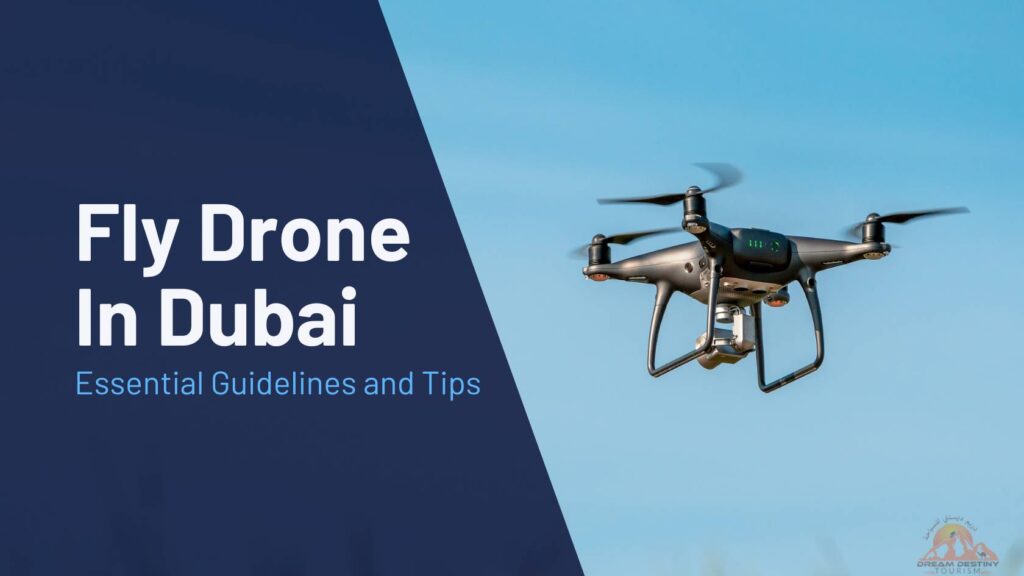Dubai, known for its towering skyscrapers and stunning landscapes, offers a captivating backdrop for drone enthusiasts. To fly a drone legally in Dubai, registration with both the General Civil Aviation Authority (GCAA) and the Dubai Civil Aviation Authority (DCAA) is required. This process ensures safety and compliance with local regulations. Although daunting at first, understanding these regulations is key to enjoying the experience without legal hassles.
Whether flying for fun or capturing images of Dubai’s iconic skyline, selecting the right drone is crucial. Considerations include the drone’s weight, features, and the rules on flying zones. It’s important to check the ‘My Drone Hub’ app to find approved areas for flying, which is an essential step to avoid fines and ensure safety.
Enthusiasts should prepare before taking flight in Dubai by planning routes and performing safety checks. Maintaining a visual line of sight and avoiding restricted areas are part of responsible flying. Safe post-flight procedures are equally important to ensure the longevity of the drone and compliance with any legal requirements.
Key Takeaways
- Legal drone flying requires registration in Dubai.
- Approved flying zones are found on the ‘My Drone Hub’ app.
- Safety checks and responsible flying prevent issues.

Dubai Drone Regulations
Flying a drone in Dubai requires adhering to specific rules. These include registering drones, understanding no-fly zones, and obtaining necessary permits for flying. Following these regulations ensures safety and compliance with Dubai’s aviation laws.
Registration Requirements
All drones used in Dubai must be registered with the General Civil Aviation Authority (GCAA). Whether used for recreational purposes or professional services like photography, each drone must have a valid registration. This process involves submitting owner details and drone specifications.
Registration ensures accountability and promotes safe flying practices. Drones that are not registered are considered illegal, and operators can face penalties. The registration process is straightforward, but attention to detail is important to ensure compliance with the regulations set forth by the GCAA.
No-Fly Zones
Dubai has strict regulations on where drones can and cannot fly. Areas near airports and military bases are designated as no-fly zones to ensure safety. The Dubai Civil Aviation Authority is responsible for establishing these zones to protect airspace and public safety.
Drone operators must consult updated maps and guidelines provided by relevant authorities to avoid these restricted areas. Flying in a no-fly zone can result in serious penalties, and it is the operator’s responsibility to be informed about these locations before taking off.
Flight Permits
Obtaining a flight permit is crucial for certain drone activities in Dubai. Depending on the purpose, such as commercial operations or flying near sensitive areas, operators may need permits from authorities like the Dubai Civil Aviation Authority.
Permit application involves submitting details of the flight plan and purpose. Approval ensures that activities comply with safety and legal standards. Timely application for permits is advised to avoid delays and ensure smooth operation of drone flights within the legal framework of Dubai’s aviation system.
Selecting a Drone
Choosing the right drone for flying in Dubai involves considering its size and type, as well as its camera and technology capabilities. Understanding these features can help users pick a drone that suits their needs and complies with local regulations.
Size and Type Considerations
When selecting a drone, the size and type are important factors. Smaller drones, weighing 5 kg or less, are typically allowed in designated zones, often referred to as the green zone, using the “My Drone Hub” app.
Recreational users might opt for a mini or micro drone. These are small, lightweight, and generally easier to handle. They are ideal for beginners who are still learning the ropes.
Commercial users may need larger drones with more capabilities. It’s also important to consider the storage and portability, especially if traveling frequently with the drone. Folding or easily dismantled drones can be quite convenient in such cases.
Camera and Technology Capabilities
The camera quality and technology features of a drone play a big role in the selection process. Drones equipped with high-resolution cameras are perfect for capturing detailed photos and videos. This is essential for both recreational enthusiasts and professionals who focus on aerial photography.
Advanced drones often come with features like GPS, obstacle detection, and return-to-home mode. These technologies can enhance safety and navigation, making the flying experience smoother.
Some drones come with features like FPV (First Person View), which allows users to see in real time. This feature is particularly popular among those interested in racing or immersive flying experiences.
Pre-Flight Preparations
Proper pre-flight preparations are essential when planning to fly a drone in Dubai. This includes checking the drone’s battery and maintenance status, assessing weather conditions, and completing necessary flight planning and notifications.
Battery and Maintenance Checks
Before any flight, the drone’s batteries should be fully charged and in good condition. Batteries should show no signs of damage or swelling, as these can lead to failure during flight. It is also important to ensure that all firmware is updated to the latest version to avoid malfunctions.
Regular maintenance checks are critical. Props should be inspected for damage, and motors tested to ensure smooth operation. Keeping a checklist can help pilots stay organized and not miss any important steps. Ground control systems should be calibrated properly.
Weather and Timing Assessments
Understanding weather conditions is crucial for successful drone flights. Pilots must ensure conditions are safe, avoiding wind and rain which can affect control and visibility. Checking a reliable weather forecast before planning a flight is recommended.
Timing the flight is also important to avoid peak heat times, as high temperatures can affect battery life. Flying during early morning or late afternoons often yields the best conditions. Awareness of local no-fly times or areas where drone operations are restricted is essential for compliance.
Flight Planning and Notification
Prior to takeoff, a comprehensive flight plan should be prepared. This includes mapping out the flight path and identifying no-fly zones that must be avoided. Making sure the area is clear of obstacles is necessary for a safe operation. Planning assists in predicting potential issues and preparing solutions.
Notifying the relevant authorities is required. Registering the flight with organizations like the Dubai Civil Aviation Authority (DCAA) is an essential step to ensure legal compliance. This may include getting necessary permits depending on the area and purpose of the flight.

Flying Safely and Responsibly
Flying drones in Dubai requires both caution and respect for local laws. Ensuring safe operation involves not disturbing others, keeping the drone within view, and preparing for unexpected situations. Here are some key points to ensure a safe and responsible flying experience.
Avoiding Disturbances
When flying drones, it’s crucial to minimize any negative impact on people and the environment. Drones should not be flown over crowded areas or private spaces without permission. This helps protect privacy and prevent accidents.
Operators should also avoid making noise that could disturb wildlife or people. Choosing quieter models and flying at appropriate times can help reduce disturbances.
Stay informed about no-fly zones in Dubai. These areas include airports and military bases, where drone activity is restricted for safety reasons. Use apps or maps to identify these zones before flying.
Maintaining Line of Sight
Keeping the drone in sight is important for controlling and preventing crashes. In Dubai, drones must not go higher than 400 feet above ground level. This rule keeps drones within a safe range and reduces interference with other aircraft.
Operators should always maintain a direct view of their drones. This helps in making quick adjustments if needed. Relying solely on cameras or sensors can be risky, as these may not capture all obstacles.
In urban areas, tall buildings and structures can block visibility. Flying in open spaces makes it easier to keep a direct line of sight and avoid potential dangers.
Handling Emergencies
Emergencies can occur unexpectedly, such as losing control due to wind or technical failures. It’s necessary to have a plan for these situations to prevent damage or harm. Drones should be equipped with reliable return-to-home features. This ensures they return safely if connection is lost.
Operators should familiarize themselves with emergency procedures, including shutting down the drone quickly if needed. Practicing these steps can help avert potential disasters.
Regular maintenance checks on the drone can prevent issues. Ensure batteries are charged, and inspect parts for wear. This proactive approach reduces the likelihood of emergencies during flight.
Post-Flight Procedures
After flying a drone in Dubai, it’s important to manage the collected data responsibly and maintain the drone for future flights. This ensures both compliance with regulations and the longevity of the equipment.
Data Management
Upon completing a flight, organize and store the data collected by the drone securely. It is crucial to back up any photos, videos, or telemetry data to a trusted storage system, such as a cloud service or external hard drive. This helps prevent data loss and makes it easier to access when needed later.
Sensitive data should be handled with care. Ensuring compliance with local privacy laws and protecting any personal or geographical information is essential. Organize data using folders and naming conventions to maintain a clear structure.
Remove any redundant or unnecessary files to save space and enhance performance. Regularly updating software tools and securing data helps align with best practices for effective drone data management.
Drone Maintenance
Once a flight is completed, inspecting the drone for any damage or wear is vital. Begin with checking the propellers. They should be free of cracks or chips, as damaged propellers can lead to unstable flights. Next, verify the integrity of the drone’s frame and body.
The battery is another key component. Remove it, allow it to cool, and then store it in a safe, dry place. It’s also wise to clean the drone. Use appropriate tools to remove dirt or debris that may have accumulated during flight, focusing on sensors and motors.
Regular maintenance ensures that the drone continues to function properly and prolongs its lifespan, preventing costly repairs or replacements. Keep a log of maintenance activities to track the drone’s condition over time.
Legal Considerations
Flying a drone in Dubai involves several legal aspects. Understanding insurance requirements and privacy laws is crucial for safe and lawful drone operations.
Insurance Requirements
In Dubai, drone operators may need insurance to cover accidents and liabilities. This requirement applies to both commercial and hobbyist use. Insurance can help protect against damage to property or injuries caused by a drone.
Without insurance, operators might face significant financial risks. The Dubai government does not explicitly mandate drone insurance for hobbyists, but obtaining it is advisable for peace of mind. Commercial operators, especially those conducting business operations, might find it essential to have comprehensive coverage. Insurance providers usually offer terms based on the drone’s specifications and intended use.
Privacy Laws
Privacy is a major concern for drone users in Dubai. Operators must ensure they respect the privacy of others while flying their drones. Laws prohibit the recording or observation of individuals without their consent.
Unauthorized drone use over private property can lead to legal issues. Dubai’s laws are strict, aiming to prevent invasions of privacy and protect personal space. Operators should always fly drones responsibly and be mindful of their surroundings. Adhering to these laws helps avoid penalties and ensures a smooth flying experience. Privacy violations can result in hefty fines or other legal actions, which can be avoided by following legal guidelines.
No related posts.







